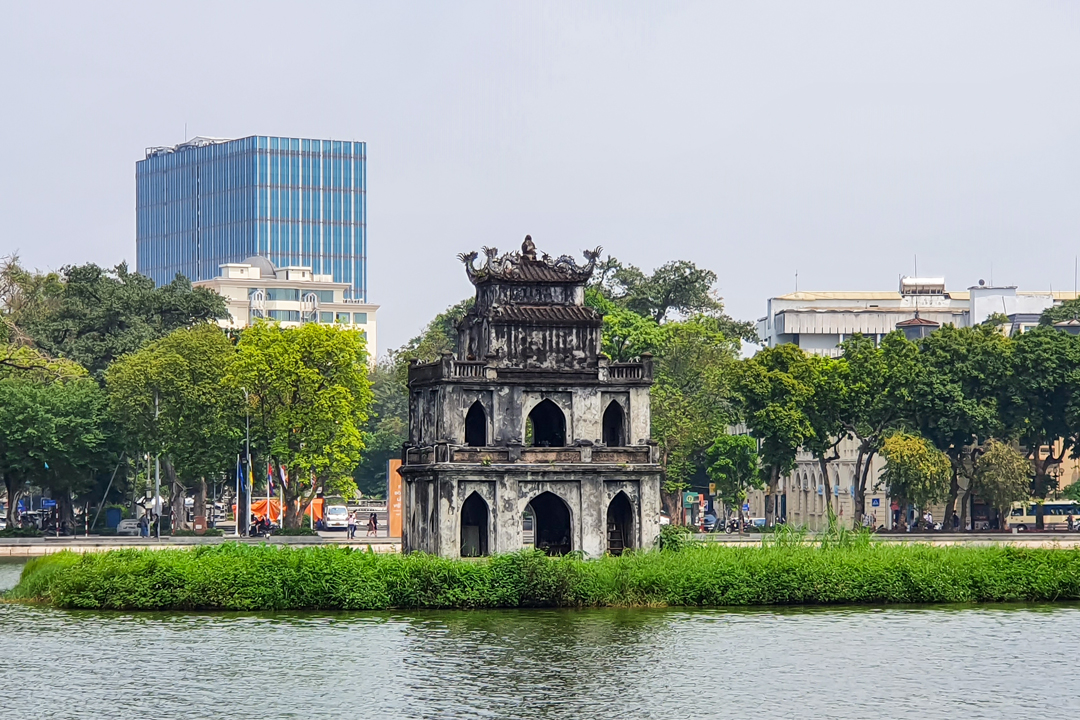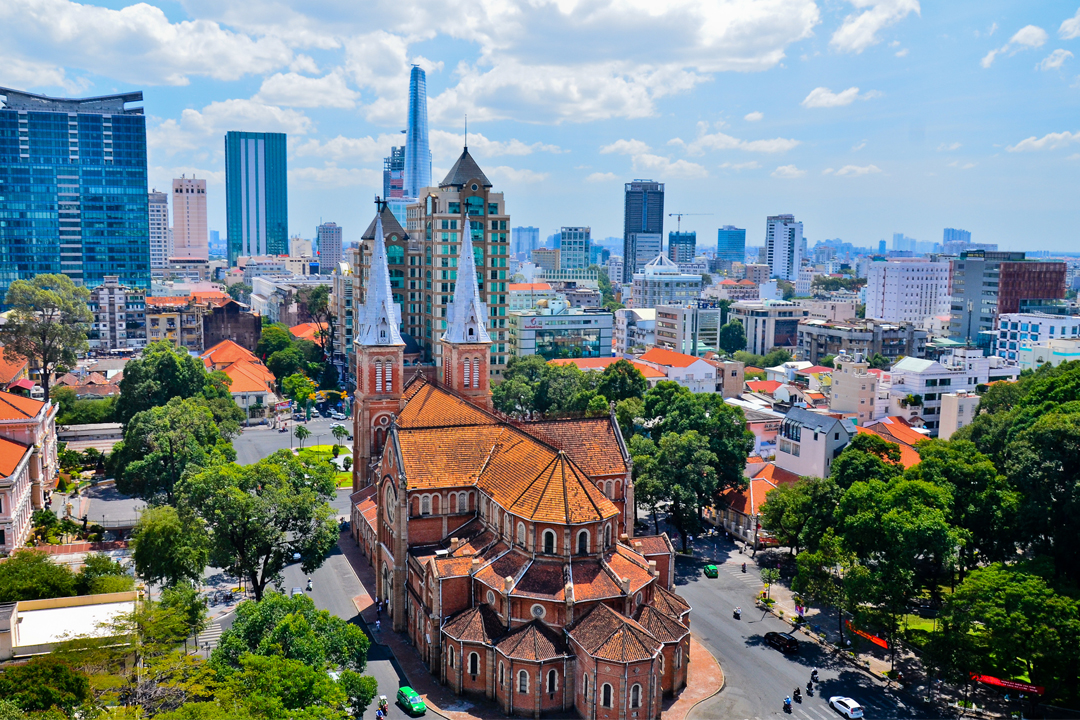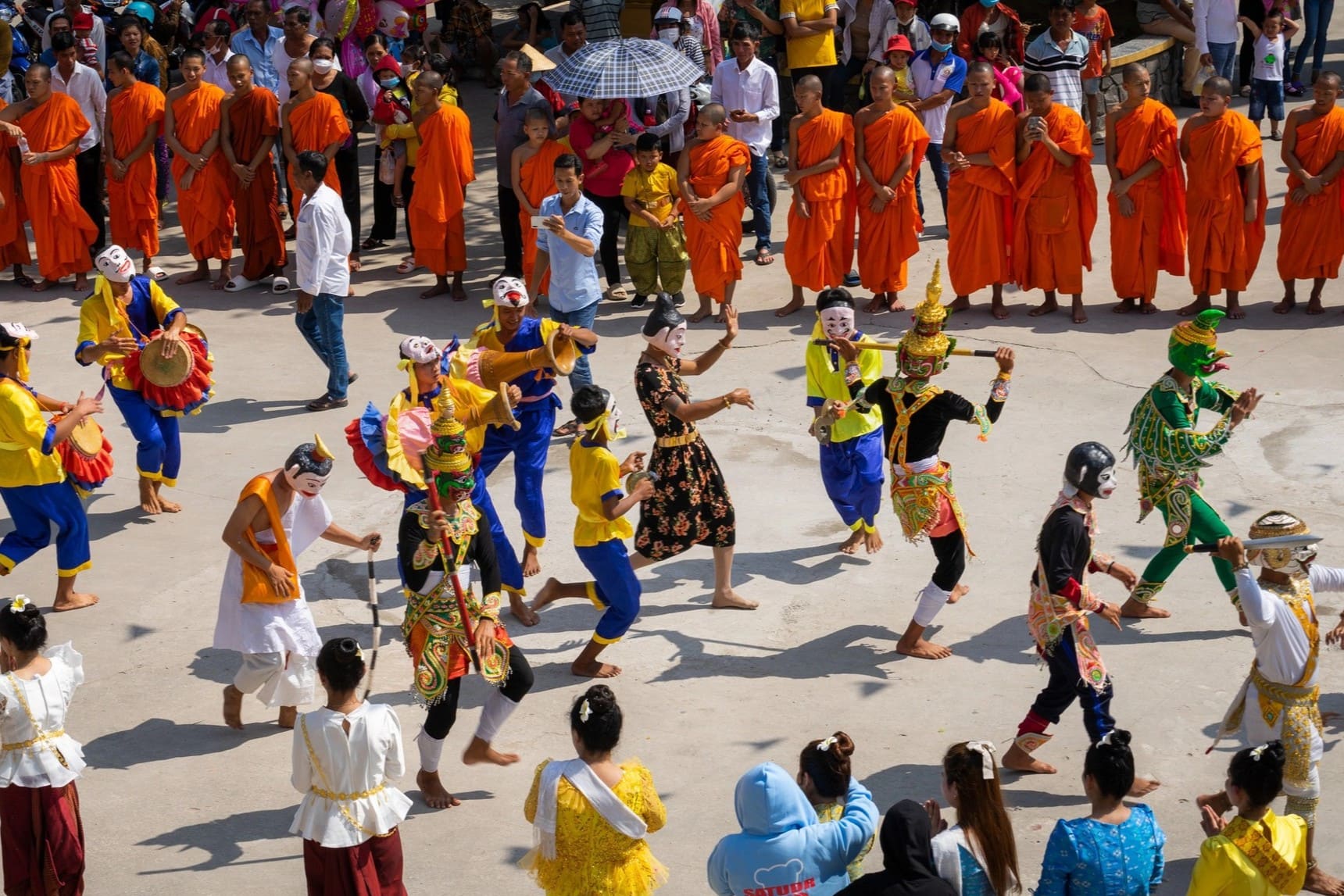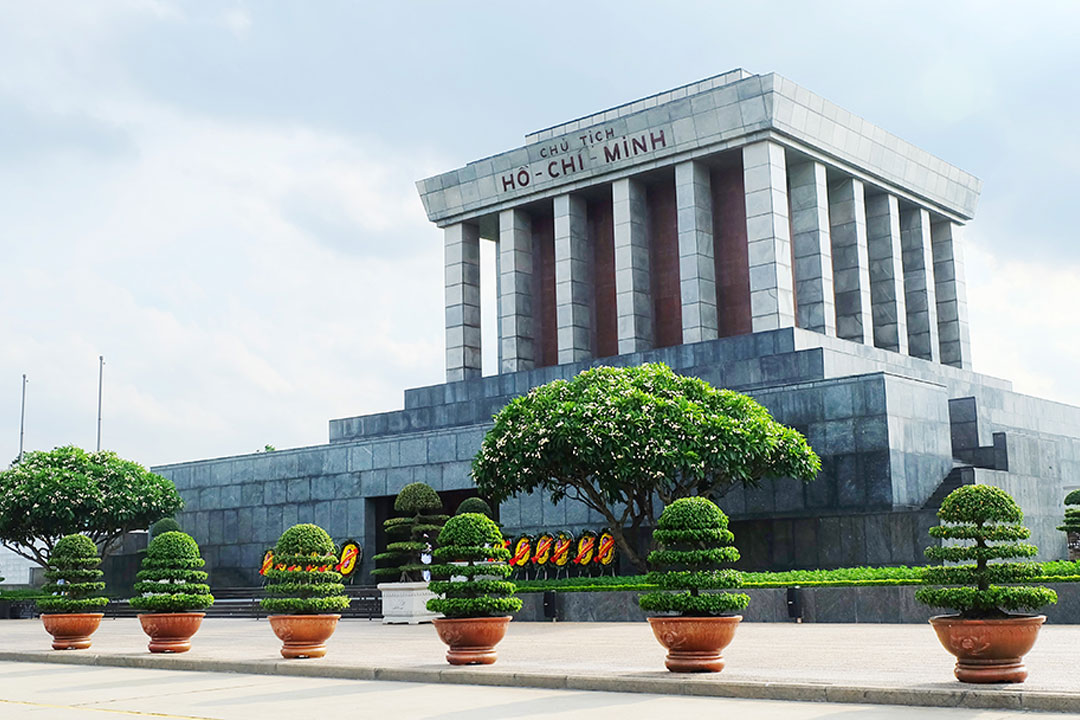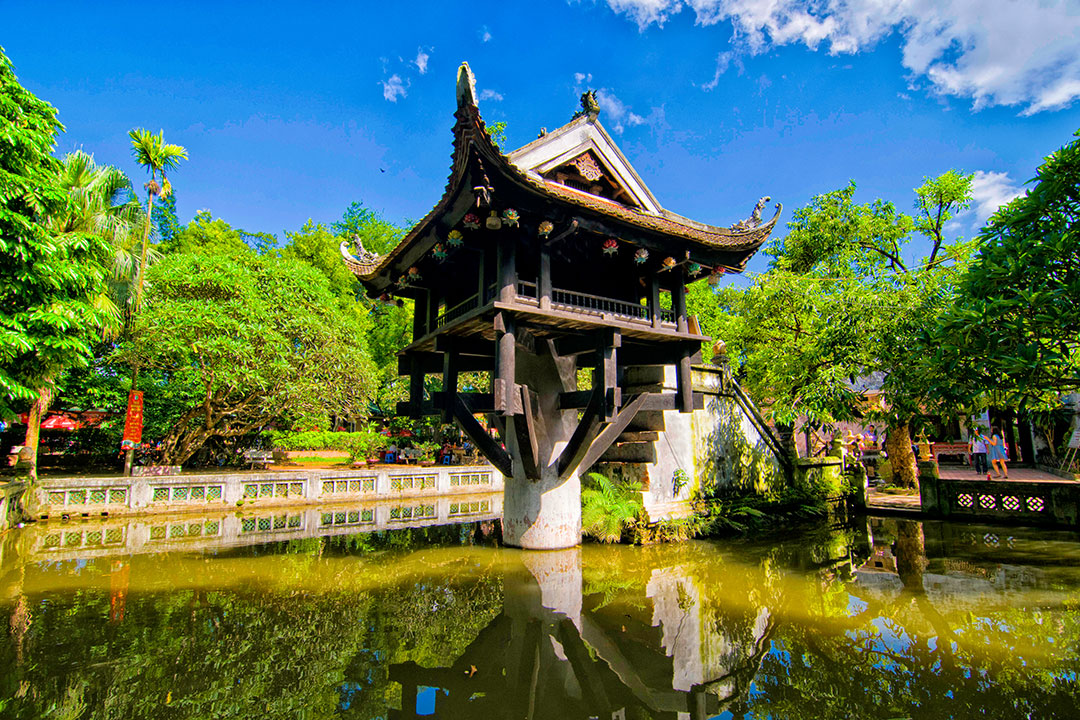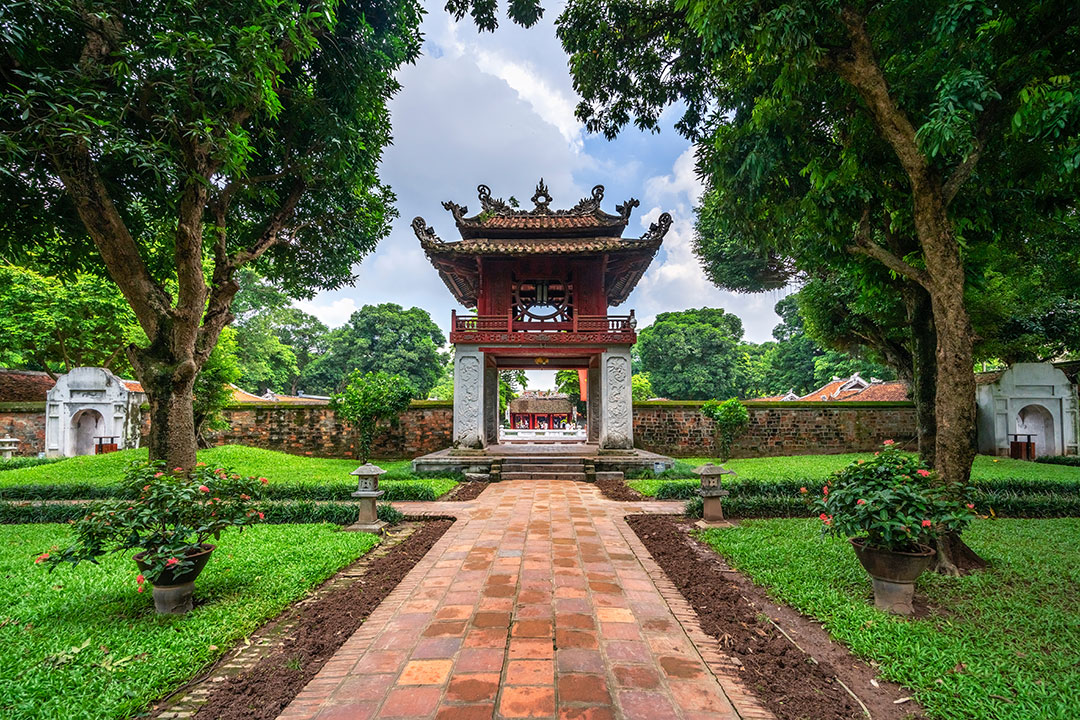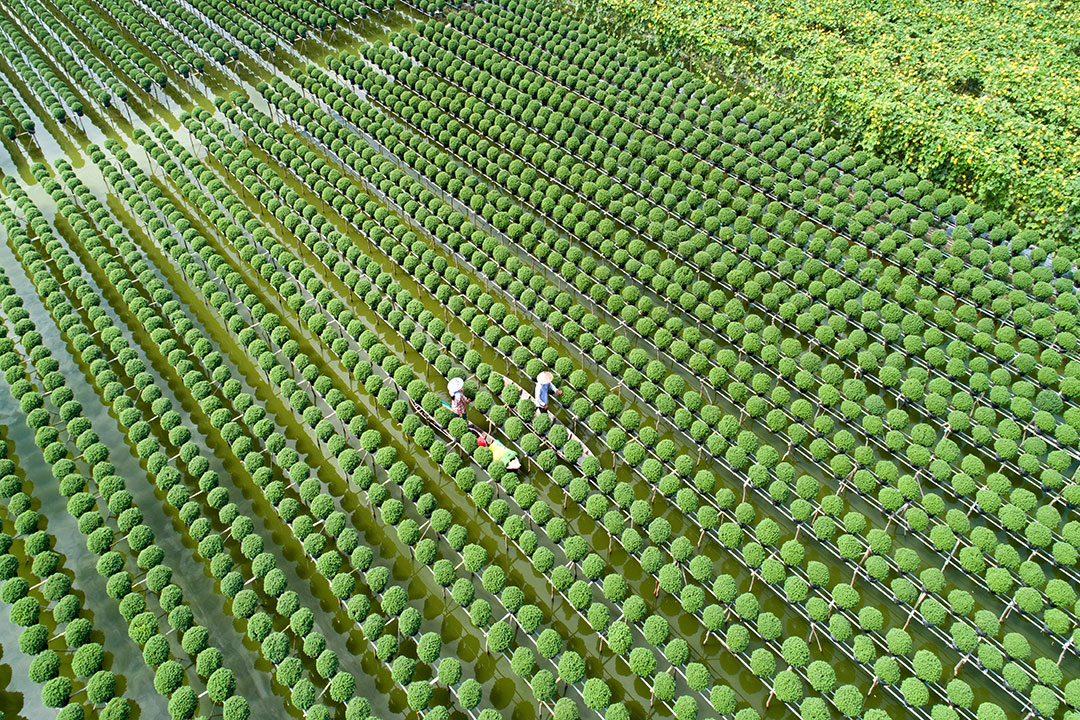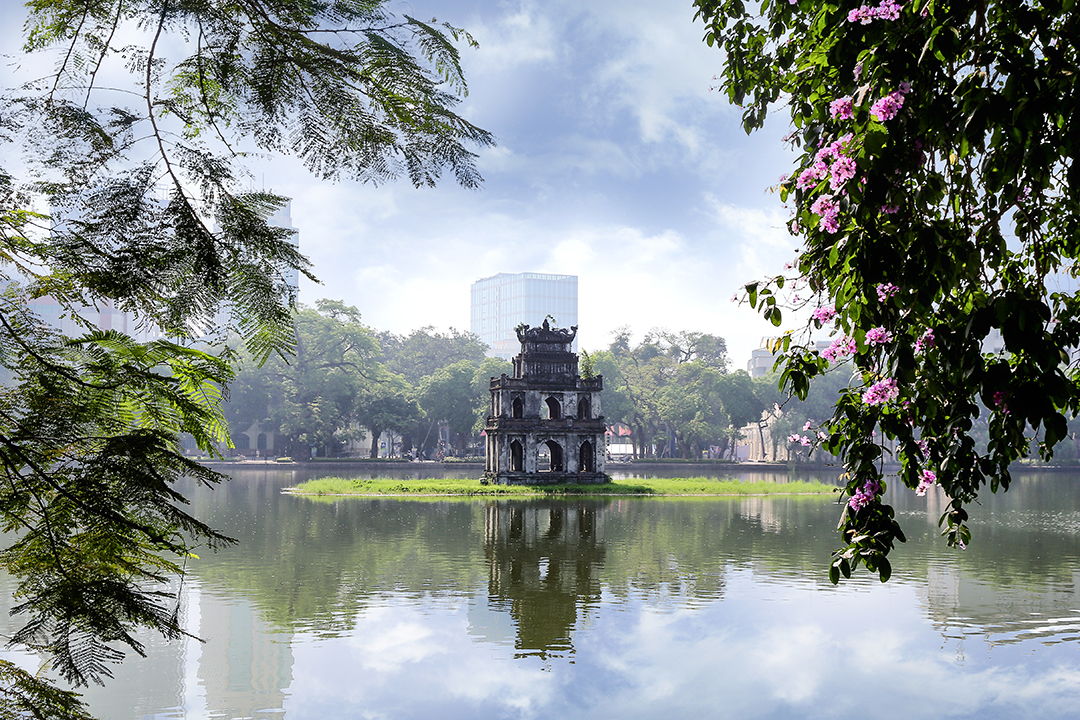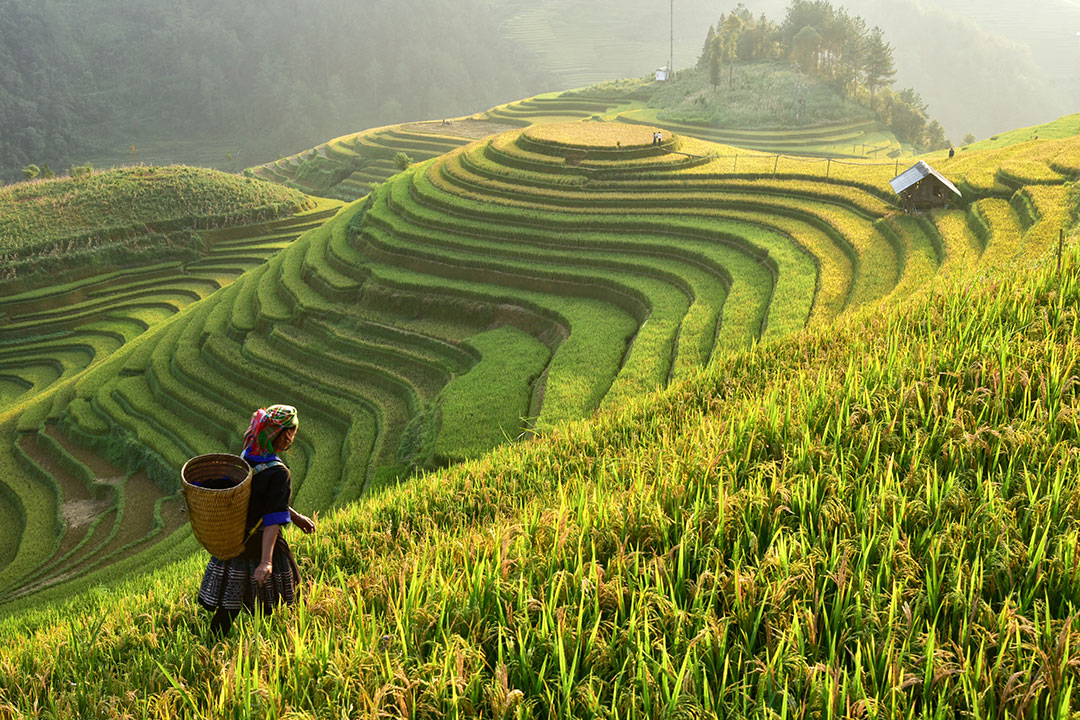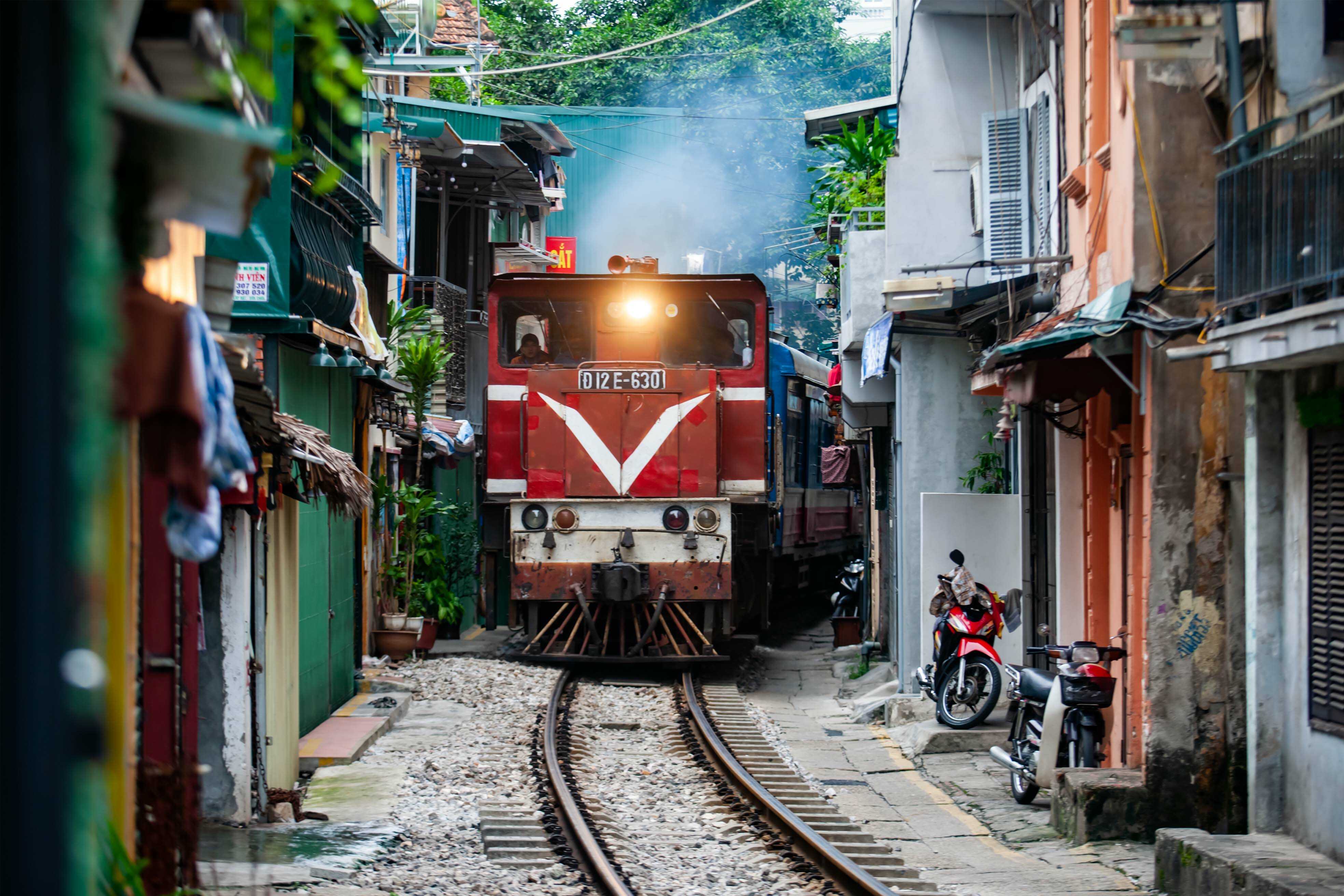Duong Lam Ancient Village: Location, Features, Things To Do & Travel Guide
Step back in time at Duong Lam Ancient Village, a living museum of Vietnamese rural life with over 1,200 years of history. Famous as the birthplace of national heroes Phung Hung and Ngo Quyen, this charming village boasts nearly 1,000 well-preserved houses made of laterite and wood, age-old banyan trees, and the iconic Mong Phu village gate. In this guide, GTrip takes you through Duong Lam’s rich history, unique attractions, and practical travel tips to help you make the most of your visit.
Where is Duong Lam Ancient Village located?
Location: About 44 kilometers west of Hanoi’s city center, in Son Tay Town, Hanoi City
Duong Lam Ancient Village is often thought of as a single village, but it is actually a collective of nine traditional villages that once belonged to the former Cam Gia Thinh area in Phuc Tho District. Among them, Mong Phu, Dong Sang, Cam Thinh, Doai Giap, and Cam Lam form the core area most commonly recognized by visitors as Duong Lam Ancient Village.
Set against a charming rural backdrop of rice fields and gentle hills, the village's location has played a significant role in its historical relevance. It lies just 15 kilometers from Son Tay Town, 70 kilometers from Noi Bai International Airport, and 35 kilometers from the scenic Ba Vi National Park. Making it a convenient and enriching day trip from Hanoi.
Exploring the village feels like stepping into a living museum, where narrow lanes wind through ancient laterite walls and centuries-old houses. Visitors can easily explore the village complex on foot or by bicycle, enjoying an immersive experience of traditional Vietnamese rural life. While the entrance fee is modest, optional services like guided tours and bike rentals are also available, offering a deeper look into the enduring heritage of this remarkable village.
Services information:
| Service | Cost |
|---|---|
| Entrance fee | About 20,000 VND ($0.8) per adult and child over 14 years old |
| Parking fee | About 10,000 VND ($0.4) per vehicle |
| Bicycle rental | About 30,000 - 50,000 VND ($1.16 - $1.9) per hour |
| Motobike rental | About 80,000 - 100,000 VND ($3 - $3.9) per day |
Though separate, the villages share a unified cultural identity, with enduring customs and architecture preserved for centuries. This cultural cohesiveness makes Duong Lam a living museum of traditional Vietnamese village life and an exceptional day trip destination.
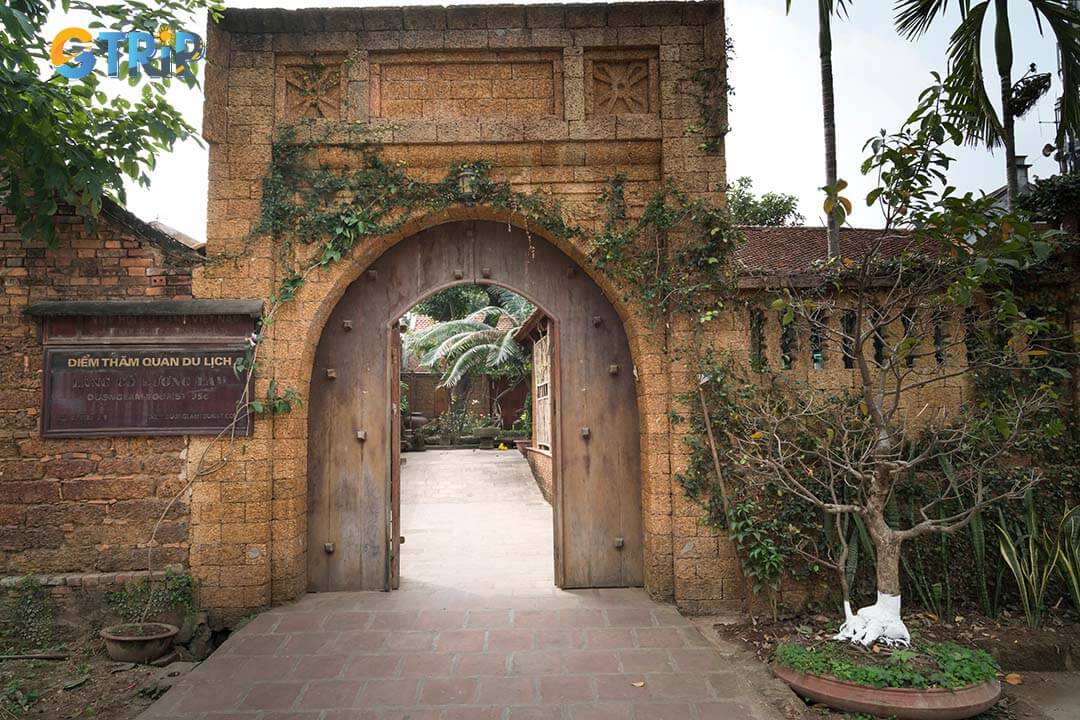
Duong Lam Ancient Village offers a peaceful escape into Vietnam’s timeless rural heritage, with centuries-old houses, quiet lanes, and rich cultural charm
What is a distinctive feature of the Duong Lam Ancient Village?
Duong Lam Ancient Village is distinguished by its exceptional preservation of traditional Vietnamese village life, spanning over 1,200 years. One of Vietnam’s oldest inhabited villages, Duong Lam is the birthplace of national heroes Phung Hung and Ngo Quyen, who fought for independence from Chinese rule. This royal heritage adds deep historical significance to the village beyond its architectural charm.
The village’s most striking feature is its nearly 1,000 well-preserved ancient houses in an area of 800.25 ha where more than 8,000 people live. Many houses are built from laterite, reddish clay material native to the region. These centuries-old homes feature oval wooden frames, red tile roofs, and brick walls, often passed down through generations. This remarkable preservation offers you an authentic glimpse into traditional Vietnamese building techniques and rural life that have largely disappeared elsewhere.
Several notable cultural landmarks enrich the village’s heritage, including the Mong Phu Village Gate. The gate was built in 1553 in the “upper house Xiamen” style, symbolizing the village boundary. The Mong Phu Communal House, also dating back to the 16th century, serving as the center for village affairs and worship. Mia Pagoda, an ancient Buddhist temple from the 17th century. Other historic family homes, such as Ba Dien’s House and Mr. Hung’s Ancient House, showcase traditional architecture and centuries of local history.
Duong Lam preserves the classic northern village layout with banyan trees, old wells, stone paths, and a tranquil countryside setting. This spatial arrangement creates a tranquil, nostalgic atmosphere that appeals to visitors seeking a retreat from modern urban life.
Beyond its physical heritage, Duong Lam is a living cultural site where traditional festivals like the Giong Church celebration are still held. Folk performances such as water puppetry and rowing songs, along with local culinary and craft traditions, continue to thrive.
Duong Lam Ancient Village was recognised as a National Art and Architectural Monument in 2005. The village has also received international praise for its conservation efforts, preserving both its tangible and intangible cultural values for future generations.
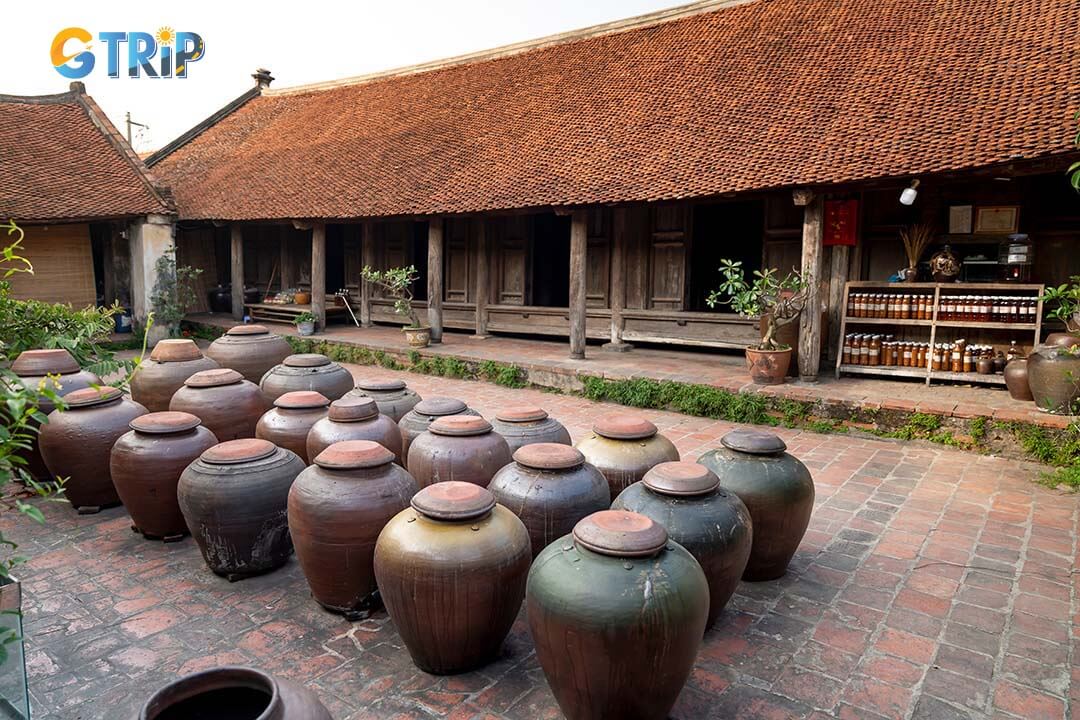
Duong Lam Ancient Village is a 1,200-year-old living heritage site, famed for its ancient laterite houses, royal history, and enduring traditions of rural Vietnamese life
Unique architectural heritage of the Duong Lam Ancient Village
Duong Lam is a living museum of traditional Vietnamese architecture, with laterite houses that reflect centuries of history. Duong Lam’s architecture embodies the northern countryside aesthetic, remarkably preserved over time. Every element, the iconic village gates and centuries-old buildings, showcases the depth of Vietnam’s cultural and architectural legacy.
The gate of the ancient village of Duong Lam - Mong Phu
Before going to visit the ancient village of Duong Lam, you will go through the gate of Mong Phu village. It was built in 1833 with arch architecture and a honeycomb layer with the bold architectural culture of the Le Dynasty. Besides the gate, there are also banyan trees more than 300 years old, providing shady shade for people to rest. This scene creates a truly peaceful, ancient and bold countryside. The gate, resembling a traditional house with tiled roofs and sturdy stone walls, stands as a symbol of the village’s enduring history and cultural identity. Passing through it, visitors feel as if stepping into a different world, immersed in the tranquil beauty of rural Vietnam.
Mong Phu Village Communal House
The Mong Phu village communal house was built 380 years ago and covers an area of 1,800 m². Its architecture is a harmonious blend of Vietnamese and Muong styles, combining stilt houses with wooden floors. Inside the communal house, there are many beautifully crafted wooden panels and intricate carvings. Here, you can learn about Muc Hung, a talented artisan known for his golden hands, who created works that still hold great artistic value today. This communal house is very special, featuring unique architectural details that you won’t find in any other communal house. So, when you visit the ancient village, don’t forget to stop by the Mong Phu village communal house.
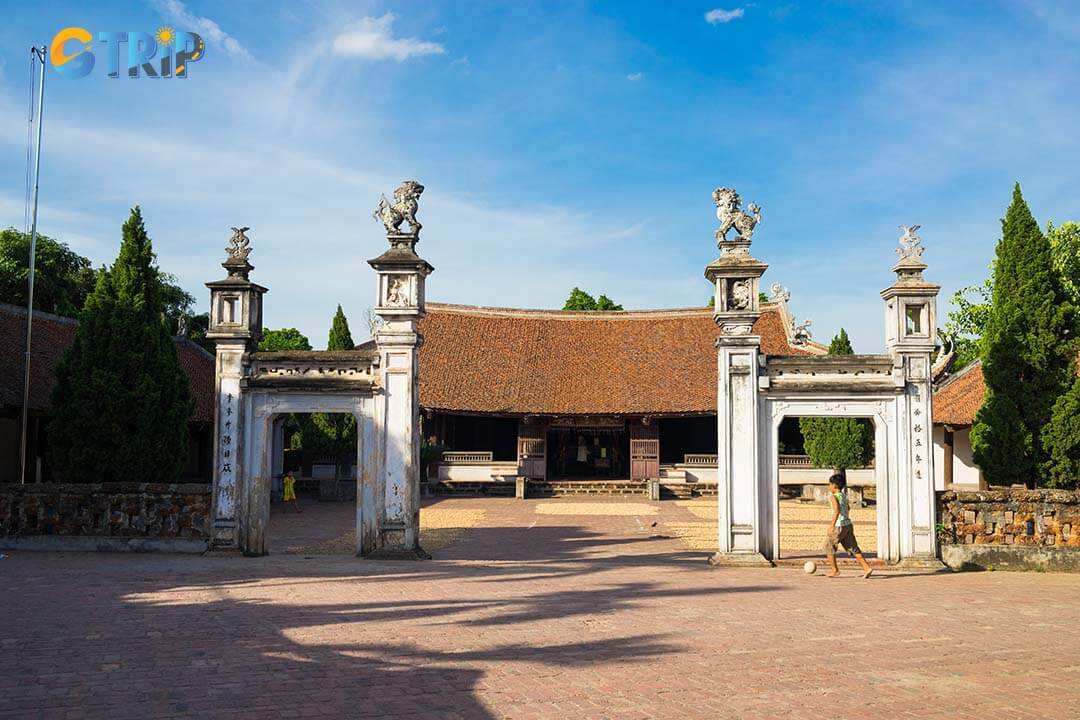
Mong Phu Communal House, a 380-year-old gem blending Vietnamese and Muong architecture, stands as a unique cultural landmark in Duong Lam Ancient Village
Mrs. Dien's ancient house - A 200-year-old house with water specialties and che lam (Vietnamese nutty ginger sticky rice bar)
Step into Mrs. Dien’s 200-year-old home, showcasing mossy walls, wooden beams, and timeless Vietnamese design. At the front yard, you may be greeted by her 95-year-old granddaughter, who is still sharp and welcoming. Take a seat, sip on traditional green tea, taste local specialties like che lam, and listen as she shares stories of the house’s history and the village’s heritage. It’s not just a visit, it's a warm, living connection to the past. Every corner of the house holds echoes of generations gone by. You’ll leave with not only a full stomach but also a heart full of quiet nostalgia.
Mr. Hung's ancient house in the Duong Lam Ancient Village
Coming to the ancient village of Duong Lam and missing Mr. Hung's house, it is indeed a huge omission when this is the oldest house in Mong Phu village. Mr. Hung's house was built in 1649, up to now nearly 400 years ago, with 12 generations of people living there. The house has an old gate built of soil, poker, and mud to create an extremely unique adhesive. If you love architecture, we will surely learn a lot of things, or seek inspiration for the last food lesson, the ancient village of Duong Lam may blow into your soul a new breeze. As soon as we arrived at the gate, we were noticed. The house is built in the traditional five-compartment style. The central three spaces are dedicated to ancestor worship and receiving guests, while the two side compartments serve as bedrooms. A distinctive street-facing door is located in the middle of the house.
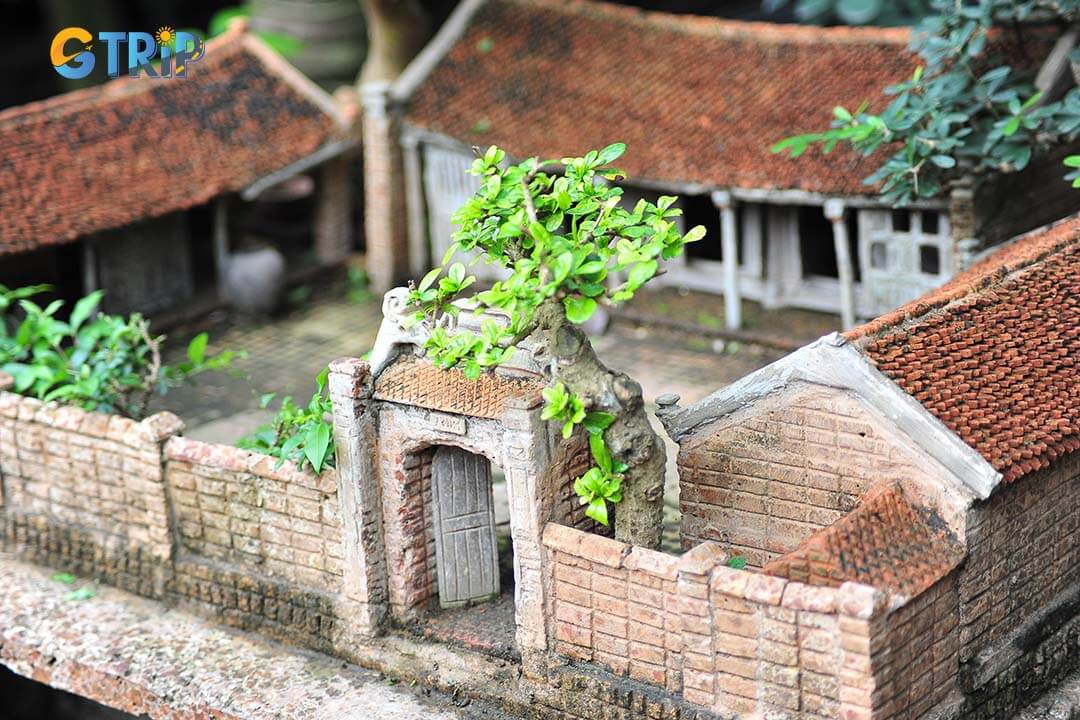
The model of simulating Mr. Hung's house
Mr. The old house - Enjoy the unique traditional rice soy sauce
A house without iron nails, what do you think? That is the house of Mr. The, located in the unlucky hamlet, Mong Phu village. All 7 spaces of the house are completely co -binded by traditional style, not using an iron nail. The equally special feature is that the soy sauce has existed from generation to generation. As soon as you step into the yard, you will hear the fragrance of soy sauce coming from the jars that are arranged close to the yard. The house also carries the breath of the Northern mountainous area when decorating the clusters hanging on the bar, and the distance is a tool to grind corn. Coming here, you must not ignore the rice soy sauce and the extremely famous lowland wines. This taste will make you love it from the first try.
Mong Phu Church
Going to Tang Lam village, one cannot fail to mention the Mong Phu church. The narrow road leading to the church with many turns to hard to find, fortunately, there is a guard. The church in the Mong Phu family stands out among hundreds of ancient roofs from above. The church is newer than the purely Vietnamese ancient houses and lacks the age-old features of Tang Lam. However, when it comes to the history of Catholicism in Vietnam, Mong Phu truly stands out. Perhaps it was because the neck of Tang Lam made this ancient religion.
Mia Pagoda
The ancient temple has a history of more than 400 years, built in 1621 in the old land called Cam Gia (Nom name is sugarcane), in the famous countryside of Doai. Mia Pagoda follows traditional "noi cong ngoai quoc" architecture, featuring structures like the Tam Quan gate, bell tower, garden, worship hall, and upper palace. The pagoda gate is designed in the style of "roofing flower field" with sophisticated dragon motifs, creating a solemn and ancient look.
A special highlight of the pagoda is a 13 -meter -high Nine -Flower Tower. It’s including 9 floors, shaped like a pen, a place to store the Buddha's relics, the meaning of feng shui "town" to protect the ancient village of Duong Lam. In the temple campus, there is also an old banyan tree hundreds of years old, creating shade and a pure space.
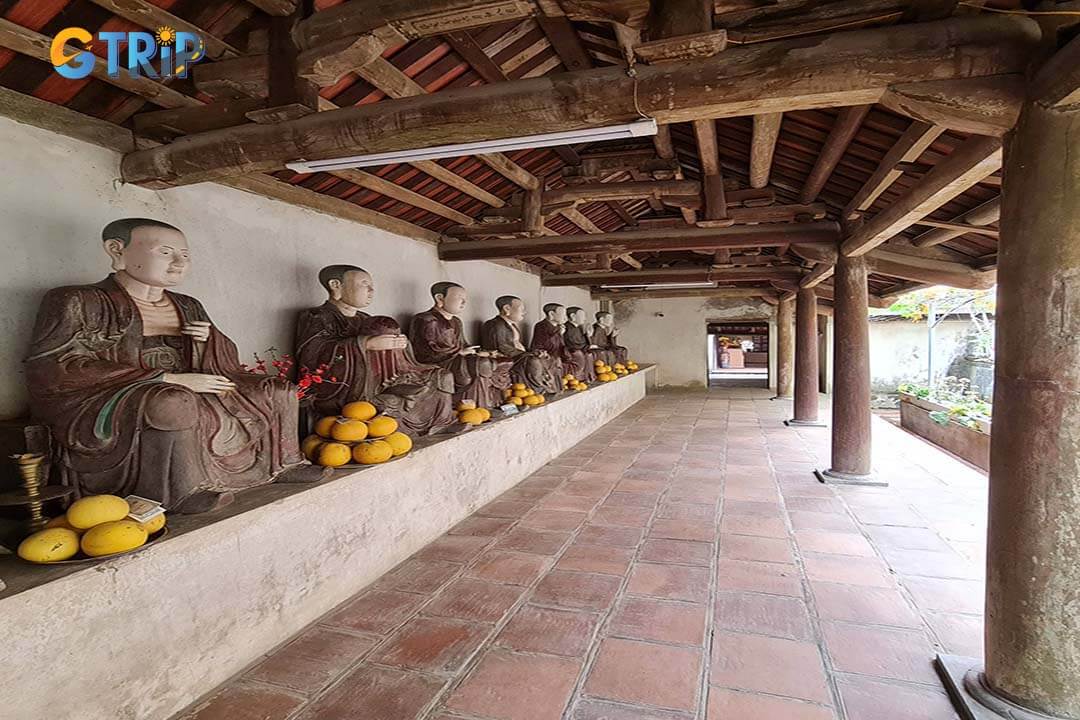
Mia Pagoda is a 400-year-old spiritual landmark known for its traditional architecture, nine-story tower, and tranquil centuries-old banyan tree
Phung Hung and Ngo Quyen Temples
Phung Hung Temple is located in Cam Lam hamlet, Duong Lam commune. It was built to honor Great Patriarch Phung Hung, who led the uprising against the Tang dynasty’s domination and established autonomy for the Vietnamese people. The current temple was extensively restored in the 19th century and includes structures such as the main gate, left and right wings, the main hall, and the rear sanctuary. The temple’s architecture features traditional Vietnamese style with tiled roofs and intricately carved wooden beams decorated with dragons, clouds, and foliage patterns. A bronze statue of Phung Hung is respectfully placed in the rear sanctuary. Surrounding the temple are many landmarks associated with his life and career, such as Vung Ham, Ho Gam Hill, and Ngoc Well.
Ngo Quyen Temple is also part of the Duong Lam Heritage Complex, located on Cam Hill. The temple features a main gate, side wings, main hall, and rear sanctuary. Though modest in size, it preserves traditional five-bay wooden architecture with a tiled roof and brick walls. The middle hall displays a horizontal plaque inscribed with the four Chinese characters “Tien Vuong Bat Vong” (meaning “King Ngo Quyen lives forever”). The rear sanctuary houses a statue of Ngo Quyen adorned with a dragon and floral motifs. The king’s tomb, built during the reign of King Tu Duc, features a stone stele pavilion. The temple grounds host 18 heritage banyan trees, where King Ngo Quyen once tied his elephants and horses before battle.
Every year, locals hold a commemorative ceremony on the 14th day of the 2nd lunar month to honor King Ngo Quyen’s legacy. Both temples serve as important spiritual and historical destinations in Duong Lam, affirming the cultural and historical value of the land known as “the homeland of two kings”, Phung Hung and Ngo Quyen. You to these sites to admire traditional architecture and gain deeper insight into the Vietnamese people’s patriotic spirit and resilience.
5 things to do at Duong Lam Ancient Village
Duong Lam Ancient Village offers visitors a genuine glimpse into Vietnam's rural heritage with numerous authentic activities. Cycling ancient lanes and joining farming activities, visitors experience Vietnam’s rural roots and traditional way of life. Here are the most rewarding activities to enjoy during your visit to this historical gem.
1. Cycle around the village and the surrounding countryside
Renting a bicycle is perhaps the most charming way to explore Duong Lam's timeless beauty. The narrow, winding lanes flanked by ancient laterite walls create the perfect setting for a leisurely ride through history. As you pedal through the village, you'll encounter:
- Ancient banyan trees that have witnessed centuries of village life
- Rice paddies stretching toward the horizon, changing colors with the seasons
- Water buffalo grazing peacefully alongside the paths
- Local farmers are going about their daily routines using traditional methods
The surrounding countryside offers even more picturesque landscapes, with emerald green fields and small hamlets that seem untouched by time. Most guesthouses and local shops rent bicycles for approximately 30,000-50,000 VND per day. This makes cycling an affordable and eco-friendly way to experience the village’s authentic atmosphere.
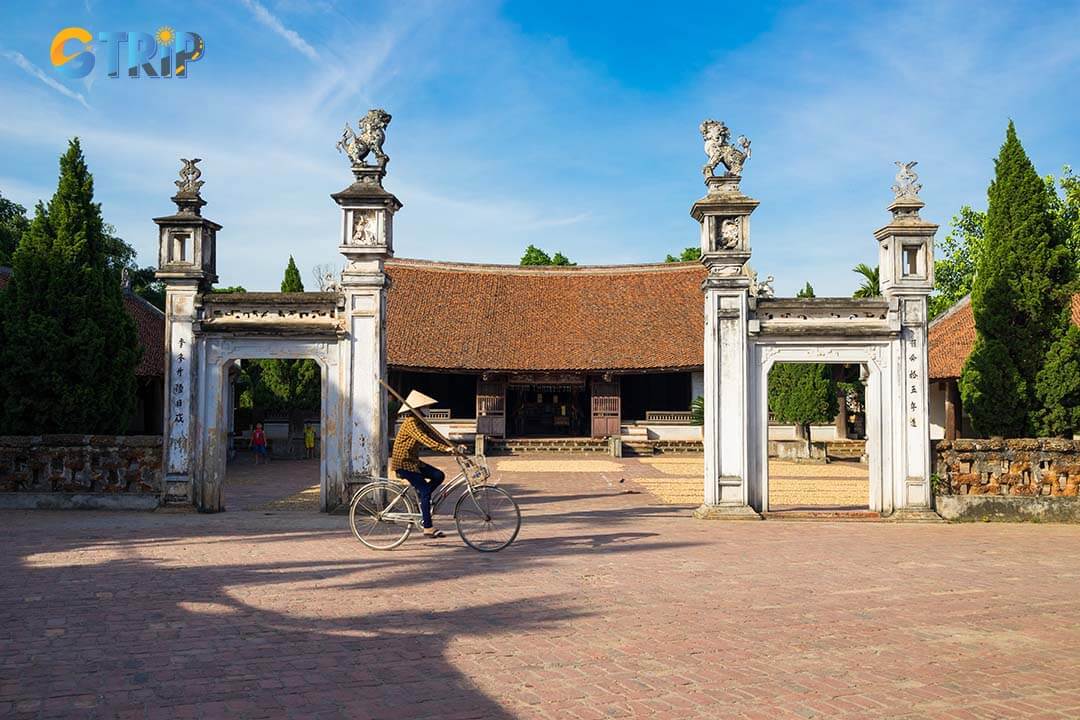
Cycling through Duong Lam’s ancient lanes offers a peaceful, authentic way to explore its timeless charm
2. Experience a day as a farmer in Duong Lam ancient village
For visitors seeking hands-on cultural immersion, participating in farming activities provides insights into the agricultural traditions that have sustained this community for generations. Depending on the season, you can join locals in:
| Farming activity | Best Season | What you'll learn |
|---|---|---|
| Rice transplanting | Spring/Summer | Traditional planting techniques |
| Harvesting | Autumn | Rice cutting and collection methods |
| Vegetable cultivation | Year-round | Organic farming practices |
| Water buffalo handling | Year-round | Working with these essential farm animals |
The rice transplanting experience lets visitors join farmers in the paddies and learn how to plant seedlings. This labor-intensive process gives profound appreciation for the effort behind every grain of rice on your plate. Several homestays in the village can arrange these farming experiences, usually including a traditional meal shared with a local family afterward.
3. Take photos with ancient wells, village gates and rustic landscapes
Duong Lam is a photographer's paradise, filled with picturesque scenes that capture the essence of traditional Vietnamese village life. The village's distinctive architectural elements provide perfect backdrops for memorable photographs.
Prime photo spots include:
- Village entrance gates: imposing structures that once protected the village
- Ancient wells: communal gathering places where villagers have collected water for centuries
- Laterite walls: weathered red walls that have stood for hundreds of years
- Ancestral houses: with their distinctive wooden architecture and intricate carvings
- Narrow alleyways: shadowed by ancient banyan trees
The best times for photography are early morning when the village is awakening and bathed in soft golden light. Late afternoon is also ideal, as farmers return from the fields and the setting sun casts a warm glow over the laterite structures. The natural, unfiltered light at these times highlights the rustic textures and rich colors of the village.

Duong Lam is a dream for photographers, offering golden light, rustic textures, and timeless scenes of traditional Vietnamese village life
4. Visit the cafes on the side of the road
The roadside cafes of Duong Lam offer more than just refreshments they provide windows into local life and culture. These humble establishments, often housed in wooden stalls with thatched roofs, create perfect rest stops during your village exploration.
Most cafes serve traditional Vietnamese beverages, including:
- Lime tea (tra chanh): a refreshing blend of green tea with lime juice
- Vietnamese nutty ginger sticky rice bar (che lam): a local specialty with a subtle, earthy flavor
- Vietnamese coffee (ca phe): strong and aromatic, served hot or with ice
Beyond beverages, these cafes offer something even more valuable, conversations with locals. Many shop owners are village elders who share fascinating stories about Duong Lam's history and traditions. The Cafe Lang shop stands out as a particular highlight, with its nostalgic wooden chairs and affordable prices (most beverages under 25,000 VND). The friendly owner, a village native, prepares excellent coffee and creates an atmosphere that evokes childhood memories for many Vietnamese visitors.
5. Enjoy local food at Duong Lam
The culinary traditions of Duong Lam represent an important element of the village's cultural heritage, with distinctive dishes that reflect the region's agricultural bounty.
Must-try local specialties include:
- Mia chicken (ga mia): Once reserved for royalty and special ceremonies, this delicacy features small-legged chickens with yellow feathers that produce exceptionally crispy, flavorful meat when boiled.
- Roasted meat (thit quay): Distinguished by its unique preparation method using small guava leaves in the marinade, creating a perfect balance of crispiness and juicy tenderness with a subtle aromatic quality.
- Vietnamese mung bean pudding (che kho): A sweet treat made from sprouted mung beans mixed with sugar and stirred until smooth. Best enjoyed cool, this dessert offers a pleasant sweetness complemented by subtle tea notes.
- Duong Lam soy sauce: This rustic condiment combines rice, soybeans, salt, and water from village wells. It's used to enhance vegetables, fried beans, preserved fish and meat with its distinctive umami flavor.
- Traditional sweets: Including sesame candy, peanut brittle, and rice cakes wrapped in dong leaves complete the village's culinary landscape. Paired with light green tea, these simple treats exemplify the authentic flavors of rural Northern Vietnam.
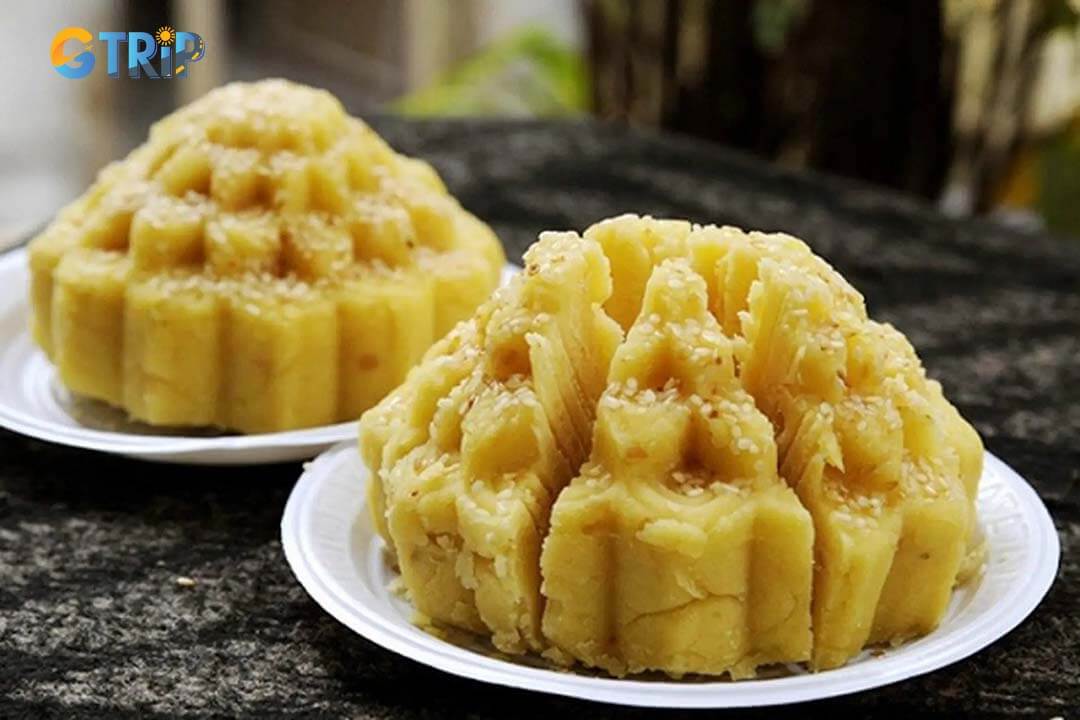
Duong Lam’s culinary heritage shines through rustic dishes like Mia chicken, guava-roasted pork, and traditional sweets, offering a true taste of rural Northern Vietnam
Best time to visit Duong Lam Village
Timing your visit to Duong Lam Ancient Village can significantly enhance your experience, as the village's charm transforms with the changing seasons. Each period offers distinct atmospheres and cultural highlights worth experiencing.
The autumn months from September to early December provide the most pleasant weather conditions for exploring Duong Lam. During this period, temperatures typically range from 20-25°C with lower humidity and minimal rainfall, creating ideal conditions for wandering through the narrow alleyways and exploring the ancient houses. The golden light of autumn enhances the rustic beauty of the laterite brick structures, making it an exceptional time for photography enthusiasts.
Spring festival season, particularly during the first lunar month, presents a cultural immersion opportunity as the village hosts traditional celebrations. The most significant is the Mong Phu - Duong Lam Festival, held from the 4th to the 10th of January on the lunar calendar. This festival, considered the most sacred holiday of the year for locals, features:
- Folk games like human chess, cock fighting, and tug of war
- Traditional performances, including ca tru (Vietnamese traditional folk song) and water puppet shows
- Processions honoring village ancestors and cultural heroes
- Food stalls offering local specialties like rice cakes and sugar-coated fruits
- Handicraft demonstrations showcasing traditional village crafts
Winter months (December-February) bring cooler temperatures and occasional light rain. While less popular with tourists, this season offers a more authentic glimpse into daily village life without crowds. The cool air pairs perfectly with enjoying hot tea in ancient courtyards and warming local dishes like sticky rice and slow-cooked pork. To avoid peak domestic tourism, consider skipping major Vietnamese holidays when the village becomes crowded with local visitors.
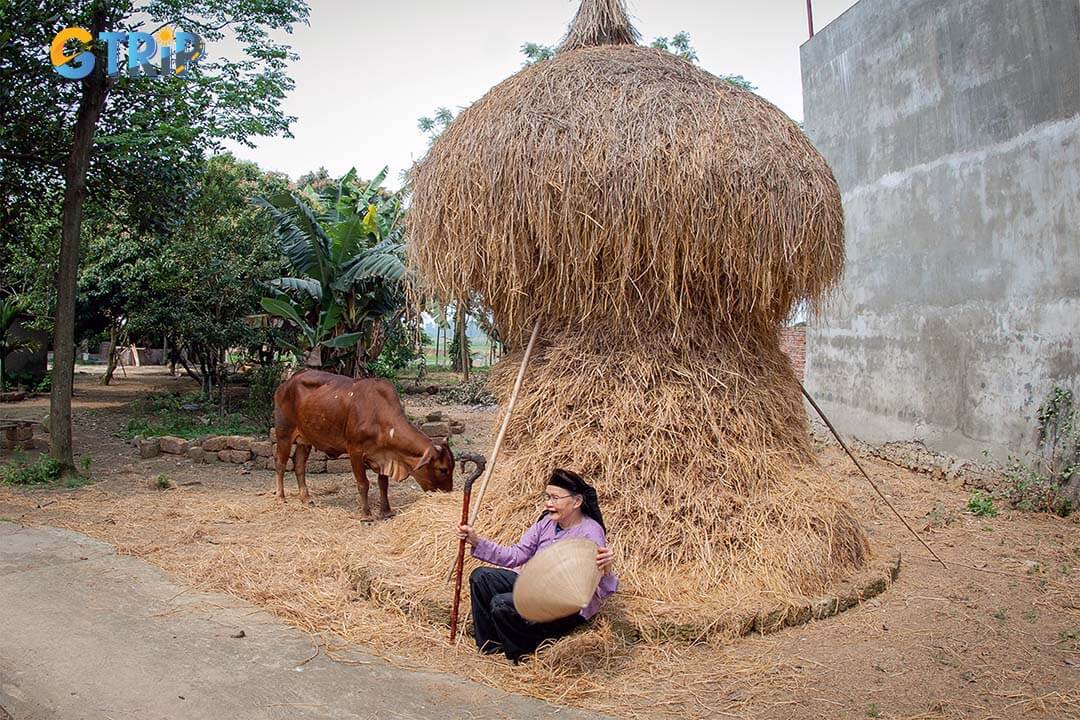
The best time to visit Duong Lam is autumn for ideal weather and stunning scenery, or during the lunar new year festival season for a rich cultural experience
How to get to Duong Lam Ancient Village?
Situated approximately 45-50 kilometers from Hanoi's city center, the village is accessible through several convenient transportation options. If you prefer public transportation, the comfort of a private car, or the adventure of a motorbike journey, reaching this historical gem is straightforward. Each method offers different advantages in terms of cost, convenience, and the overall experience of your journey to this cultural treasure.
By bus
The most economical way to reach Duong Lam is via public bus transportation from Hanoi, following these routes:
- Route 71: Depart from My Dinh bus station to Son Tay bus station (ticket price: 14,000 VND / $0.60)
- Route 70: Travel from Kim Ma wharf to Son Tay bus station
- Route 77: Journey from Ha Dong bus station to Son Tay bus station
Once you arrive at Son Tay bus station, you'll need to arrange the final leg of transportation:
- Motorbike taxis cost approximately 70,000-80,000 VND ($3-3.50) for the 10km journey
- Traditional taxis charge roughly 100,000-150,000 VND ($4.30-6.50)
- Local buses run less frequently but are available for around 7,000 VND ($0.30)
The entire journey typically takes 1.5-2 hours, depending on traffic conditions and waiting time between connections. Planning ahead can help ensure a smooth trip and make the most of your time.
By car
Traveling by car offers maximum comfort and convenience for visiting Duong Lam Ancient Village.
Route options:
- Via National Highway 32: The most direct route through the western suburbs of Hanoi
- Via Thang Long Boulevard: Slightly longer but often less congested, especially during rush hours
Travel details:
- Duration: 1-1.5 hours (traffic dependent)
- Distance: Approximately 45-50 kilometers from central Hanoi
- Road conditions: Generally well-maintained with clear signage
Transportation costs:
| Vehicle type | Estimated round-trip cost | Notes |
|---|---|---|
| Standard taxi | 600,000-800,000 VND ($25-35) | Meter fare plus waiting time |
| Private car service | 800,000-1,200,000 VND ($35-50) | Includes driver and waiting time |
| Grab Car | 500,000-700,000 VND ($22-30) | It may be difficult to find a return ride |
For greater convenience, consider booking a car with a driver through your hotel or a travel agency. These services often include guided assistance and can help arrange introductions to local village hosts.

Traveling by car is the most comfortable and flexible way to reach Duong Lam, with routes taking 1 - 1.5 hours from central Hanoi, depending on traffic
By motorbike
For adventurous travelers, exploring Duong Lam by motorbike offers unmatched freedom and an authentic Vietnamese travel experience.
Rental information:
- Daily motorbike rentals in Hanoi range from 130,000-150,000 VND ($5-6.50)
- Automatic scooters typically cost more than semi-automatic or manual bikes
- Most rental shops require a passport deposit or a cash security deposit
Journey details:
- Duration: 1-1.5 hours each way
- Route: Follow Thang Long Boulevard to National Highway 32, then continue toward Son Tay
- Road conditions: Generally good, with some rural sections near the village
Important safety considerations:
- Always wear a helmet (required by law)
- Carry a physical map or download offline maps, as network coverage may be spotty
- Bring rain gear during the monsoon season (May-October)
- Fill your tank before leaving Hanoi
- Consider the return journey timing to avoid riding after dark
The motorbike option gives you the flexibility to stop at scenic countryside viewpoints and explore neighboring villages at your leisure, creating a more immersive travel experience beyond just the destination itself.
Accommodations at Duong Lam Ancient Village
Staying overnight in Duong Lam offers a unique chance to experience authentic village life. Accommodations here combine ancient architecture with modern comforts, stilted wooden houses and restored heritage homes, offering a rich glimpse into rural Vietnam’s past.
Doai Homestay
Address: No. 14 Dinh Hamlet, Duong Lam Ancient Village, Hanoi
Prices: from 700,000 to 1,200,000 VND per night
Doai Homestay represents the perfect marriage of traditional architecture and modern comfort. The property features an enchanting wooden house on stilts alongside a contemporary building that provides additional conveniences.
The homestay's gardens create a tranquil atmosphere where guests can enjoy Vietnamese coffee and local delicacies at the on-site cafe. What truly sets Doai apart is its commitment to cultural immersion through organized activities. You can participate in guided village tours, try their hand at traditional painting workshops, or witness the ancient art of shadow puppet theatre, all without leaving the property.
Amenities:
- Traditional wooden stilt house with authentic design elements
- Modern building section with private outdoor bathrooms
- Lush garden cafe serving Vietnamese coffee and local specialties
- Cultural activity program including village tours and workshops
- On-site restaurant offering northern Vietnamese cuisine prepared with local ingredients
- Wi-fi connectivity throughout the property
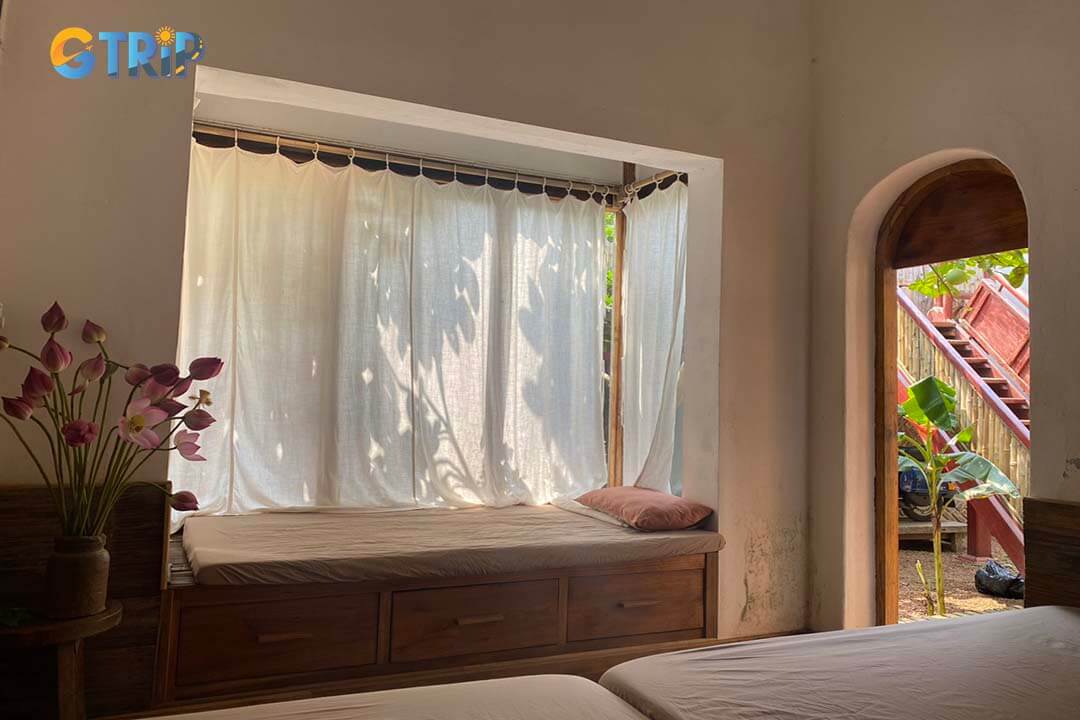
Doai Homestay blends heritage charm with modern comfort, offering stilt-house stays, cultural activities, and a serene garden café in the heart of Duong Lam
Elephant's House - Duong Lam Homestay
Address: Sai crossroads, Mong Phu, Duong Lam, Son Tay, Ha Noi
Prices: about 600,000 and 1,000,000 VND per night (approximately $25-$43)
Elephant's House provides convenient access to Duong Lam's cultural treasures while offering a peaceful retreat after a day of exploration. This strategically positioned homestay combines accessibility with comfort.
The property's serene garden views create a relaxing atmosphere that complements the cultural immersion of the village. After exploring ancient houses and historical sites, guests can return to air-conditioned comfort and modern amenities. The included breakfast service introduces travelers to local flavors, starting each day with an authentic taste of regional cuisine.
Amenities:
- Tranquil garden views and peaceful surroundings
- Free wifi throughout the property
- Complimentary parking for guests with vehicles
- Air-conditioned rooms for comfort in all seasons
- Daily breakfast service featuring local specialties
- Easy walking access to village attractions
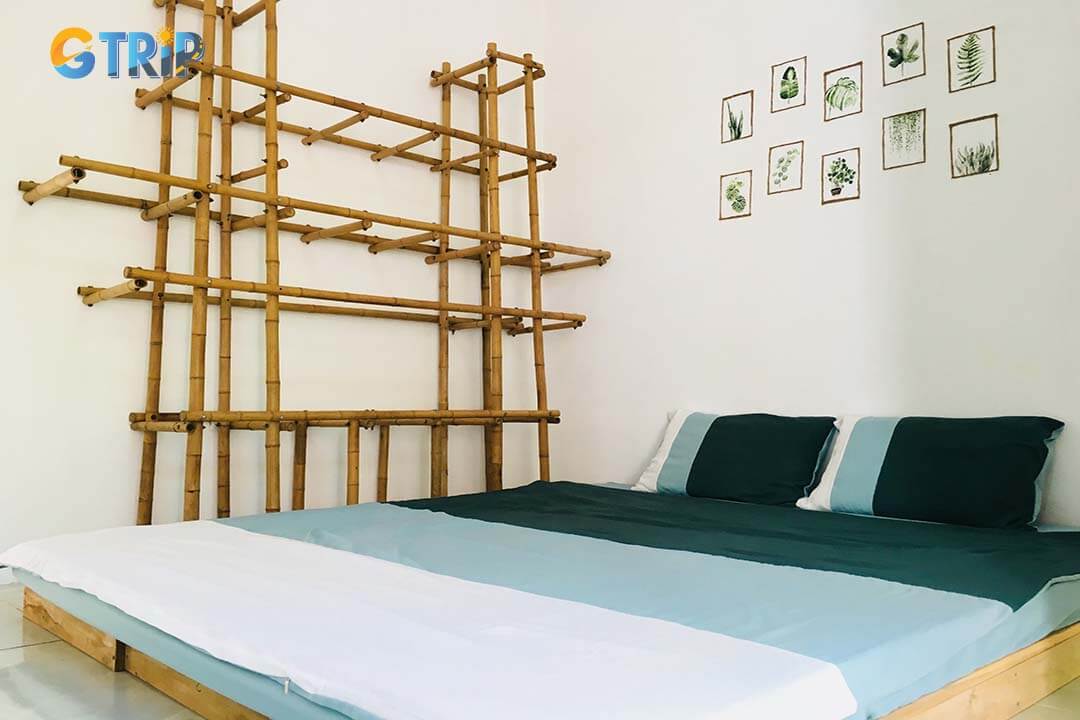
Elephant's House offers a peaceful garden retreat with modern comforts and local breakfast, conveniently located for exploring Duong Lam’s cultural sites
Nok Studio
Address: Mong Phu, Duong Lam, Son Tay, Ha Noi
Prices: about 800,000 VND per night (about $34)
Nok Studio stands out as a creative fusion of traditional Vietnamese architecture and contemporary design sensibilities. Located in the Mong Phu Hamlet area of Duong Lam and near the Doai Homestay, this unique accommodation offers an artistic take on the village stay experience.
The distinctive feature of Nok Studio is its herbal bath experience, available exclusively to overnight guests. This traditional wellness practice incorporates local herbs and provides a deeply relaxing end to a day of village exploration. Each morning, guests enjoy a complimentary breakfast featuring the local speciality banh te Duong Lam, a culinary introduction to the village's gastronomic heritage.
Amenities:
- Authentic architecture with thoughtful modern design elements
- Essential modern comforts: air conditioning, hot water, and in-room refrigerator
- Traditional herbal bath experience (overnight guests only)
- Complimentary breakfast featuring local specialty banh te Duong Lam
- Free wifi and comfortable common areas

Nok Studio blends traditional Vietnamese architecture with modern design, offering a unique stay complete with herbal baths and local breakfast in Duong Lam
Travel tips when visiting Duong Lam Ancient Village
Exploring Duong Lam Ancient Village requires some preparation to fully appreciate its historical significance and cultural authenticity. The following practical tips will help you navigate this ancient treasure with ease while respecting local customs and maximizing your experience.
- Wear comfortable footwear and clothing: The village features cobblestone paths and earthen roads that can be uneven, making comfortable walking shoes essential for exploring the sprawling ancient complex.
- Bring cash: Most local vendors, homestays, and food stalls in the village don't accept credit cards or digital payments, so carry sufficient Vietnamese dong for your purchases and experiences.
- Respect the locals' privacy: While many houses are open to visitors, remember some buildings are private homes where families still live, so always ask permission before entering or taking photos of residents.
- Hire a local guide: Consider engaging a knowledgeable local guide who can provide deeper insights into the village's 1,200-year history and hidden stories that you might otherwise miss.
- Start early: Beginning your visit in the morning allows you to avoid both the midday heat and potential afternoon tour groups, giving you a more peaceful experience of the ancient atmosphere.
- Sample local specialties: Don't leave without tasting traditional delicacies like "che lam" (Vietnamese rice cake), "com" (young rice), and "mien" (glass noodles) that have been prepared using centuries-old recipes.
- Bring sun protection: The village offers limited shade in some areas, so pack sunscreen, a hat, and sunglasses, especially if visiting during Vietnam's hot season.
- Allocate at least half a day: To truly appreciate the ancient houses, communal buildings, temples, and cultural demonstrations, set aside 4-5 hours for a comprehensive visit.
- Learn basic Vietnamese phrases: While not essential, knowing simple greetings and thank-you expressions will enhance your interactions with friendly villagers who may have limited English skills.
- Be mindful of photography etiquette: Always ask before photographing residents, religious ceremonies, or inside ancient houses where flash photography may sometimes be prohibited.
- Visit on weekdays if possible: Weekends bring more domestic tourists, while weekdays offer a more authentic and tranquil experience of traditional village life.
- Support local crafts: Purchase handcrafted souvenirs directly from artisans in the village to support the preservation of traditional craftsmanship and local livelihoods.
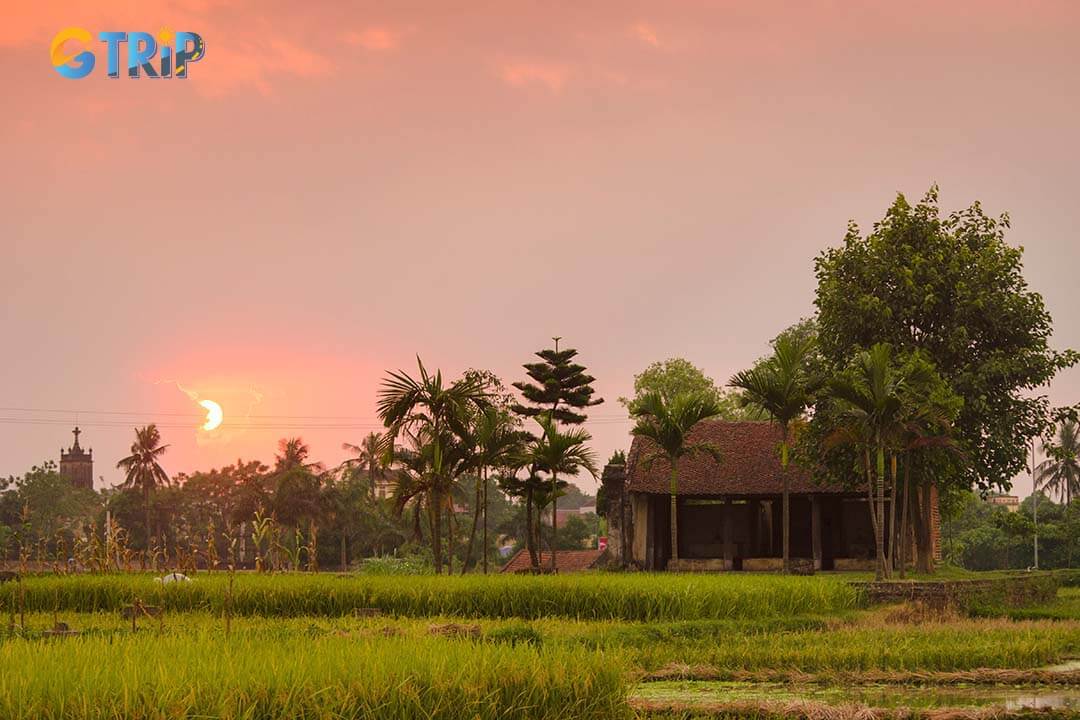
Visit Duong Lam with comfy shoes, cash, respect, a guide, early start, sun protection, local food, and support crafts
FAQs about Duong Lam Ancient Village
As you plan your visit to this remarkable cultural heritage site, you may have some specific questions about customs, accommodations, and other practical matters. Below, we've compiled answers to some frequently asked questions that will help you prepare for a respectful and enjoyable experience at Duong Lam Ancient Village.
Are there any rules for visitors regarding photography?
Photography is welcome in Duong Lam Ancient Village, but visitors should respect cultural norms and residents' privacy. When photographing the ancient houses and public areas of the village, you're free to capture images without specific restrictions. However, be mindful of the following guidelines:
- Ask for permission before photographing residents, especially elderly villagers
- Avoid using flash photography inside ancient houses and temples, as it may damage artifacts and disturb the atmosphere
- Respect "no photography" signs in certain sacred areas of temples and communal houses
- Do not climb on structures or move objects for a better photo angle
- Be considerate when photographing family altars or religious ceremonies
For professional photography or filming (commercial purposes, documentary work, etc.), you need to obtain permission from the village management board beforehand. A small fee might apply for professional photography sessions.
Can visitors stay overnight in Duong Lam village?
Yes, visitors can experience authentic village life by staying overnight in Duong Lam. This immersive option allows you to witness the peaceful rhythm of the village after day tourists have departed.
Most homestays are located in centuries-old houses, offering visitors a rare opportunity to experience life in an authentic, ancient Vietnamese dwelling. Hosts typically provide:
- Home-cooked meals featuring local specialities
- Cultural activities such as making rice cakes or traditional crafts
- Stories about village history and customs
- Assistance with arranging local guides
Booking in advance is strongly recommended, especially during weekends and holidays. The village has a limited number of accommodations, and they fill up quickly during peak tourism seasons. You can arrange bookings through tour operators in Hanoi or by contacting the Duong Lam Village Tourism Management directly.
Duong Lam Ancient Village offers a truly immersive journey into Vietnam's rich heritage and timeless charm. Your exploration here isn't just about seeing ancient architecture but feeling it, understanding how life has evolved within these walls over centuries. This visit enriches your appreciation for history, culture, and the slower pace of life that persists amid modern hustle. You've gained insights that blend history with tangible experiences, making your visit genuinely rewarding.
If you're planning to continue exploring Vietnam or delving deeper into such cultural wonders, your day at Duong Lam whispers stories you'll carry with you long after you leave. If curiosity is knocking at the door of your wanderlust, exploring other hidden gems can enrich your travel experiences. Each step forward promises new stories and memories, waiting to be discovered with GTrip on future adventures.

